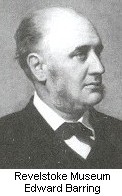|
Farwell
 1885 was a pivotal
year for the fledgling Canadian Pacific Railway, founded only four years earlier in
February 1881. Almost complete, Canada's "National Dream" was on the verge
of bankruptcy. 1885 was a pivotal
year for the fledgling Canadian Pacific Railway, founded only four years earlier in
February 1881. Almost complete, Canada's "National Dream" was on the verge
of bankruptcy.
A small town named Farwell was also close to the important historical events taking
place in 1885. First surveyed by Arthur Stanhope Farwell, a clergyman's son born in
Derbyshire England in 1841, the town was located beside the Columbia River in the
Monashee Mountains of British Columbia. It consisted of one main street and several
wooden shacks. Some designated as, quote, Hostess Houses, unquote. Farwell had done
some surveying work for the British Columbia government so he was well aware of where
a railway would cross the Columbia. He staked a claim to 175 acres and laid out the
townsite fully expecting the CPR to pass through his land thereby making him wealthy.
It didn't happen. The CPR found
another location for it's station and the town of Farwell and it's future moved there
with it. A.S. Farwell sued the CPR and won the court battle but ultimately lost the
war. But we're getting ahead of our story, let's step back a bit.
In 1881 the Federal Government had granted $25 million and 25 million acres of land
for construction of a railway to the Pacific Coast across a relatively new nation. The
government stipulated the railway must be complete by 1891. Some considered this to
be far too extravagant a gift. Upon the incorporation of Canadian Pacific Limited, in
1881, the principal directors immediately purchased $5 million in shares providing cash
to start building the railway.
Construction commenced, the Canada Central Railway was merged, and sections of railway
previously built by the government were absorbed into the new company. William
C. Van Horne was hired in December 1881 and immediately went to work in Winnipeg
while George Stephen, with his banking experience, looked after financial affairs
from Montreal.
During 1881-82 the company raised $9 million from the sale of land grant bonds but
following this the market was exhausted. The land boom had ended. By 1885 only an
additional $1 million had been sold from the $15 million available. During this time
construction furiously devoured cash. In some instances, in British Columbia, one
mile cost 3/4 million dollars. By 1883 the company had raised just $20 million which
included the $5 million subscribed by the directors through the purchase of common
stock.
The railway's floating debt kept increasing just as three principal directors quit;
Hill, McIntyre, and Kennedy. Stephen had no option but to buy them out. Had their
stock been dumped on the open market it surely would have been the end of the company.
So, by 1883, permanent capital was exhausted and they were surviving on loans.
Shares were used to gain an additional loan of $5 million while three directors,
Stephen, Smith, and Angus put up almost $4 million of their personal holdings from
the Saint Paul Minneapolis & Manitoba Railroad to secure this loan.
Public money was no longer available as Stephen wrote to Prime Minister Sir John A.
MacDonald in 1883: "Something must be done at once to put the company out
of discredit or we better give up and let the government step in and carry on the
business of the company". (Archives Canada MacDonald Papers Vol. 268
#122029)
This was the start of many pleas to MacDonald, known as "Old Tomorrow",
requesting help.
Eventually, after acrimonious debate in the House of Commons, the government responded
with an advance of $7.5 million along with stringent conditions making the railway
subservient until the loan could be repaid. All the company's assets were now tied up
by the government making it impossible to borrow anywhere else.
By December 1884 a total of 3,474 miles had been assembled from Montreal to the West
and yet tracks were still not connected on the east and west of Farwell.
In February 1885 money was so tight Stephen and Smith pledged the last of their
personal fortunes to meet a dividend of $650,000 which came due while construction
still proceeded.
A letter from Van Horne in April stated: "Have no means of paying wages, pay car
can't be sent out, and unless we get immediate relief we must stop. Please inform
Premier and Finance Minister. Do not be surprised, or blame me, if an immediate and
most serious catastrophe happens". (Archives Canada MacDonald Papers Vol. 268
#122104)
Not far from Farwell at end-of-track, fueled by liquor, the workers struck.
Superintendent Sam Steele's, of the Royal Northwest Mounted Police, constable shot and
wounded the striker's ringleader during a riot. Quieted, the labourers grudgingly
returned to work.
 About this time, farther east
in the province of Saskatchewan, one of Canada's significant historical events
occurred. The Riel Rebellion. Troops from Ontario, sent west via the incomplete and
dangerously close to bankrupt railway, arrived to crush the rebellion. Suddenly the
importance of our first nation-wide railway became apparent to all. About this time, farther east
in the province of Saskatchewan, one of Canada's significant historical events
occurred. The Riel Rebellion. Troops from Ontario, sent west via the incomplete and
dangerously close to bankrupt railway, arrived to crush the rebellion. Suddenly the
importance of our first nation-wide railway became apparent to all.
Stephen continued to press for relief from "Old Tomorrow". As MacDonald
hesitated, one of his ministers pointed out that "the government and the party
would sink with the CPR" if support were not provided. Finally, on July 10th, the
House of Commons voted in favour of a relief bill.
With this demonstration of support by the government Stephen was able to sell CPR
bonds in England. Baring Brothers, a financial firm headed by Edward Baring, Lord
Revelstoke, took the entire issue producing enough cash to complete the railway. Out
of gratitude the town of Farwell was renamed Revelstoke to honour Lord Revelstoke.
Bibliography
Canadian Pacific A Brief History
J. Lorne McDougall - 1968
McGill
University Press
The Last Spike
Pierre Burton - 1971
McClelland and Stewart Ltd.
History of the Canadian Pacific Railway
W. Kaye Lamb - 1977
MacMillan
Publishing Co.
The CPR West
Hugh A. Dempsey - 1984
Douglas & McIntyre Ltd.
Canadian Pacific in the Selkirks
Jan Booth - 1985
B.R.M.N.A.
Rail Tales from the Revelstoke Division
Ruby Nobbs - 2000
Friesens
Corporation
Associated Links
Canadian Pacific Railway
© Copyright 2002 William C.
Slim
pacificcoast.net/~slim
|